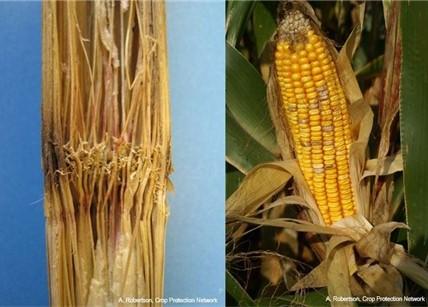Scouting For Ear and Stalk Rots in Corn
With corn harvest underway across the state, growers may be encountering ear rots and stalk rots in affected fields. The degree of severity is dependent on a variety of factors, so it is wise to scout fields prior to harvesting in order to identify problematic fields and give those harvest priority.
Several different pathogens can cause ear rots in Maryland; the main contenders are listed in the table below.
| Disease | Pathogen | Symptoms | Mycotoxin |
|---|---|---|---|
| Fusarium ear rot | Fusarium verticillioides | “Starburst” kernels, white kernels, infected kernels may be scattered on ear | Fumosin |
| Gibberella ear rot | Fusarium graminearum | Ear covered in white mat often with pink hue, infection starts at tip and can progress to butt end of ear | Vomitoxin (DON) |
| Diplodia ear rot | Stenocarpella maydis and S. macrospora | White fungal mat on ear, may cover the entire ear | None |
| Penicillium ear rot | Several Penicillium species | Blue-grey spores on kernels developing on damaged ears (hail, deer feeding, insects, birds, etc.), may infect the germ of the kernel | Some species may produce mycotoxins |
| Trichoderma ear rot | Trichoderma viride | Green spores in between kernels | None |
| Aspergillus ear rot | Aspergillus flavus | Olive green spores on ear, usually starting at tip, associated with damaged ears (feeding from insects, deer, birds, etc.) | Aflatoxin |

Although they typically do not affect yield, they can cause grain quality issues through the production of mycotoxins. Furthermore, if infected grain is not dried quickly or to a low enough moisture content, infection can spread, even when in the bin. Therefore, it is important to scout and identify fields that are infected with ear rots and harvest those first. It is better to pay a few cents in propane (although more expensive than in years past) to dry the wet grain than to wait and risk infection levels getting worse, and the potential for elevated mycotoxin concentration in the grain. Quickly dry infected grain to 15% for short-term storage and to below 13% for long term storage. It is important to note that not all ear rotting fungi produce mycotoxins, so I would recommend sending samples to a lab (the UMD Plant Diagnostic Clinic is a free service) to get proper identification so that you know the species in question and thus if mycotoxin contamination is a concern.
Stalk rots are also a harvest concern. Like ear rots, stalk rots are also caused by many different pathogens, several of which are listed in the table below. No single factor causes stalk rots; they are rather the end result of a host of factors that contribute to a net deficit in plant carbohydrates needed for grain fill. The grain fill process is a major carbohydrate sink for the plant. As the plant produces carbohydrates through photosynthesis, it allocates almost all of it’s carbohydrate production to filling the kernels. A healthy plant will have sufficient leaf area to maximize photosynthesis and therefore produce enough carbohydrates to fill the grain. However, when photosynthetic leaf area is compromised, the plant cannot make enough food to fill the kernels. In order to compensate for the deficit, the plant cannibalizes carbohydrates from existing tissues. The first tissues to go are the stalks, which are then easily compromised by stalk-rotting pathogens.
Any factor that reduces leaf area or reduces photosynthesis after pollination will predispose plants to stalk rots. These include reduced leaf area through insect feeding, lesions from foliar diseases, or mechanical damage (such as hail). Other factors include inadequate fertility, water stress, and excessive plant populations. Another significant factor is hybrid genetics; both resistance ratings to stalk rotting pathogens as well as ear and kernel size. High-yielding, large kernel hybrids are more susceptible to stalk rots if they are not kept healthy through grain fill.
Scout fields for stalk rots as early as black layer. The “pinch test” is one way to scout for stalk rots. Pinch the stalk in between the nodes at one of the lower two nodes. You should not be able to pinch healthy stalks, but rotted stalks will fairly easily collapse. Do this at random to assess the field. Alternatively, you can do a “push test,” which involves pushing the corn stalks approximately 30 degrees from horizontal (8 inches laterally) at a height of about eye level. Healthy stalks will return to vertical while infected plants will not. If more than 10% of plants tested exhibit stalk rot symptoms, you may want to harvest as soon as possible or risk a not-so-fun harvest of lodged corn.
| Disease | Pathogen |
|---|---|
| Anthracnose stalk rot | Colletotrichum graminicola |
| Diplodia stalk rot | Stenocarpella maydis |
| Charcoal rot | Macrophpmina phaseolina |
| Gibberella stalk rot | Fusarium graminearum |
| Fusarium stalk rot | Multiple Fusarium species |
This article appears in October 2022, Volume 13, Issue 7 of the Agronomy news.
